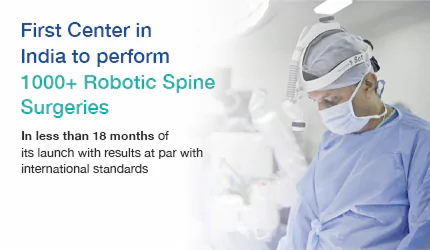When Mid-Back Problems Affect Your Entire Body
If you're experiencing unusual symptoms like a band of tightness around your chest, difficulty walking long distances, or a burning sensation that wraps around your ribs, you might be dealing with something most people haven't heard of – thoracic spinal stenosis. Unlike the more common lower back stenosis that many people know about, thoracic stenosis affects the middle section of your spine and can cause symptoms that might make you think something is wrong with your heart, lungs, or abdomen.
Thoracic spinal stenosis is less common than stenosis in the neck or lower back, but when it occurs, it can significantly impact your daily life. Understanding this condition and your treatment options is crucial for making informed decisions about your care.
Understanding Thoracic Spinal Stenosis
What Makes Thoracic Stenosis Different?
Your thoracic spine is the middle section of your back where your ribs attach. This area is naturally more stable than your neck or lower back because of the rib cage, which is why stenosis here is less common but can be more complex to treat.
Thoracic spinal stenosis occurs when the spinal canal – the tunnel that houses your spinal cord – becomes narrowed in this mid-back region. This narrowing can compress the spinal cord or nerves, leading to a unique pattern of symptoms that often confuse both patients and doctors.
What This Feels Like to Patients?
Common symptoms include:
-
Band-like chest pain that wraps around your ribs
-
Burning or electric sensations in your torso
-
Walking difficulties or leg weakness
-
Balance problems that worsen with activity
-
Numbness or tingling that follows your ribs around to the front
-
Muscle spasms in your back or chest area
In severe cases:
-
Bladder or bowel control problems (this requires immediate medical attention)
-
Significant leg weakness affecting mobility
What makes this confusing: These symptoms can mimic heart problems, lung issues, or abdominal conditions, which is why thoracic stenosis is often diagnosed later than other spine problems.
What Causes Thoracic Stenosis?
Most common causes:
-
Age-related changes – thickening ligaments, bone spurs, disc bulging
-
Arthritis of the spine joints
-
Previous spinal injuries or fractures
-
Genetic factors leading to naturally narrow spinal canals
Less common causes:
-
Spinal tumours or cysts
-
Inflammatory conditions like rheumatoid arthritis
-
Previous spine surgery complications
Advanced Diagnosis at MIRSS
Diagnosing thoracic stenosis requires specialised evaluation because symptoms can be misleading:
-
Comprehensive neurological examination to identify specific patterns of nerve involvement
-
High-resolution MRI scans to visualise spinal cord compression and signal changes
-
CT scans, if needed, to assess bone structure and calcification
-
CT myelogram in complex cases to better define spinal cord compression
-
3D imaging reconstruction for precise surgical planning
This thorough evaluation helps determine not only the presence of stenosis but also the severity of spinal cord compression and the best treatment approach.
Treatment Options: From Conservative to Surgical
Conservative Treatment First
Many patients with mild to moderate thoracic stenosis can be managed without surgery:
Non-surgical approaches:
-
Anti-inflammatory medications to reduce swelling and pain
-
Physical therapy focusing on posture, core strengthening, and flexibility
-
Activity modification to avoid positions that worsen symptoms
-
Injections in the spine to reduce inflammation around nerves
-
Bracing in specific cases to support the spine
When conservative treatment works:
-
Symptoms remain manageable
-
Function is maintained or improved
-
Pain doesn't significantly interfere with daily activities
When Surgery Becomes Necessary?
Surgery may be recommended when:
-
Progressive neurological symptoms such as increasing leg weakness
-
Spinal cord compression is visible on MRI scans
-
Severe pain that doesn't respond to conservative treatment
-
Walking difficulties that significantly impact quality of life
-
Bladder or bowel dysfunction (this is a surgical emergency)
Surgical Options: Laminectomy and Fusion
Thoracic Laminectomy: Creating Space
What it involves: A Laminectomy removes the lamina (the roof of the spinal canal) to create more space for the compressed spinal cord and nerves.
When laminectomy alone is sufficient:
-
Single-level stenosis
-
Good spinal stability
-
No significant deformity
-
Younger patients with good bone quality
When Fusion Becomes Necessary?
Spinal fusion is often added to a laminectomy in thoracic stenosis because:
-
The thoracic spine relies on bone structure for stability
-
Removing bone can create instability
-
Multiple levels often need treatment
-
Prevention of future problems at treated levels
Laminectomy with fusion involves:
-
Decompression: Removing bone and ligament to relieve pressure
-
Stabilisation: Placing screws and rods to support the spine
-
Fusion: Adding a bone graft to permanently connect the vertebrae
Factors Determining the Approach
Laminectomy alone may be considered when:
-
Single-level involvement
-
Excellent bone quality
-
No pre-existing instability
-
Minimal bone removal required
Fusion is typically needed when:
-
Multiple levels are involved
-
Significant bone removal is required
-
Pre-existing instability exists
-
Previous spine surgery at the same levels
Advanced Surgical Technology at MIRSS
At MIRSS, we employ cutting-edge robotic technology to enhance surgical precision and patient safety:
Robotic-Assisted Surgery
Our MazorX Stealth Edition (Medtronic) – an advanced spine robot with integrated navigation capabilities – provides:
-
Precise preoperative planning using 3D models of your specific anatomy
-
Real-time surgical guidance during bone removal and hardware placement
-
Enhanced accuracy in screw placement through complex thoracic anatomy
-
Reduced tissue trauma through optimised surgical approaches
Intraoperative Imaging
High-resolution cone beam CT during surgery allows:
-
Real-time verification of implants/screw placement
-
Planning and guidance for bony resection
-
Planning decompression procedures
-
Navigation for powered instruments
Specialised Surgical Environment
Our state-of-the-art modular operating theatres feature:
-
Integrated robotic and imaging systems
-
Optimal positioning for thoracic spine procedures
-
Advanced monitoring capabilities
The Surgical Process at MIRSS
Before Surgery
Your surgical team will:
-
Create detailed 3D surgical plans using robotic planning software
-
Review your specific stenosis pattern and spinal cord compression
-
Discuss the procedure and expected outcomes with our dedicated spine anesthesia team
During Surgery
The procedure typically takes 2-4 hours, depending on the number of levels:
-
Anaesthesia: Our specialised spine anaesthesia team provides comprehensive care throughout the procedure.
-
Positioning: Careful face-down positioning to optimise surgical access while protecting all pressure points.
-
Robotic-Guided Decompression: Precise removal of lamina and any compressive elements using robotic navigation.
-
Spinal Cord Assessment: Direct visualisation to ensure adequate decompression.
-
Fusion (when needed): Robotic-guided placement of screws and rods for stabilisation.
-
Bone Grafting: Placement of bone graft material to promote fusion.
-
Neuromonitoring: Intraoperative neuromonitoring continuously tracks spinal cord function throughout the procedure.
-
Final Verification: Comprehensive imaging to confirm adequate decompression and proper hardware placement.
Our specialized OR staff experienced in thoracic spine procedures coordinate throughout this complex surgery.
Recovery: What to Expect
In the Hospital
-
Most patients stay 2-3 days after surgery (depends on patient to patient)
-
Pain management with multimodal approaches
-
Early mobilization with physical therapy guidance
-
Respiratory therapy to prevent pneumonia
-
Monitoring for any complications
Recovery Timeline
First 2 Weeks:
-
Initial wound healing
-
Gradual increase in walking
-
Pain management and medication adjustment
-
Follow-up appointment for wound check
Weeks 2-8:
-
Progressive activity increase
-
Beginning of formal physical therapy
-
May require thoracic brace for support
-
Continued restrictions on lifting and twisting
Months 2-6:
-
Laminectomy patients: Progressive strengthening, return to most activities
-
Fusion patients: Ongoing fusion healing, gradual activity increase
- Regular follow-up to monitor healing progress
6+ Months:
-
Laminectomy patients: Full activity as appropriate
-
Fusion patients: Solid fusion typically achieved, return to full activities
-
Long-term follow-up as needed
Rehabilitation with MIRSS
Our dedicated spine physiotherapy team creates comprehensive recovery programs focusing on:
-
Core strengthening to support the thoracic spine
-
Posture training to prevent future problems
-
Breathing exercises to optimize lung function
-
Gradual activity progression appropriate for your specific procedure
What Improvement to Expect?
Realistic expectations:
-
Pain relief: Most patients experience significant improvement in back and chest pain
-
Neurological recovery: Leg weakness and numbness often improve, though recovery may take months
-
Walking ability: Usually improves significantly if surgery is performed before severe damage
Overall function: Most patients return to their desired activity level
Important to understand:
-
Full recovery takes time: 3-6 months for complete healing
-
Some limitations may remain: Especially with multilevel fusion
-
Adjacent level stress: May develop over time
-
Revision surgery: Occasionally needed
Warning Signs to Watch For
Contact your doctor immediately if you experience:
-
Increasing back or leg pain
-
New weakness in legs or arms
-
Bladder or bowel control problems
-
Signs of infection (fever, wound drainage)
-
Breathing difficulties
Success Rates and Long-term Outcomes
Thoracic laminectomy with or without fusion has success rates:
-
Pain relief: 80-90% of patients experience significant improvement
-
Neurological improvement: Most patients see improvement in leg symptoms
-
Walking ability: Usually improves significantly
-
Quality of life: Most patients report substantial improvement
Important considerations:
-
Earlier surgery generally leads to better outcomes
-
Complete neurological recovery may not always be possible
-
Fusion procedures have longer recovery times but provide excellent stability
-
Long-term follow-up is important
Why Choose MIRSS for Thoracic Spine Care?
Comprehensive Expertise
-
Experienced thoracic spine surgeons specialising in complex stenosis cases
-
Multidisciplinary team including specialised anaesthesia, nursing, and rehabilitation specialists
-
Specialised OR staff trained in thoracic spine surgery protocols
Advanced Technology
-
Advanced spine robotic surgery with integrated navigation
-
Intraoperative high-resolution imaging for real-time surgical guidance
-
Comprehensive neuromonitoring for spinal cord protection
-
State-of-the-art facilities designed for complex spine procedures
Patient-Centered Care
-
Thorough evaluation to determine the optimal surgical approach
-
Personalised surgical planning based on your specific anatomy
-
Comprehensive rehabilitation programs
-
Long-term follow-up and support
Questions to Ask Your Doctor
Before making treatment decisions, consider asking:
-
Do I need fusion in addition to a laminectomy, and why?
-
What are my specific risks based on the severity of my stenosis?
-
How will this affect my daily activities long-term?
-
What happens if I choose not to have surgery?
-
How experienced is the surgical team with thoracic spine procedures?
Moving Forward
Thoracic spinal stenosis can significantly impact your quality of life, but modern surgical techniques offer excellent outcomes for appropriately selected patients. The key to success lies in:
-
Accurate diagnosis and evaluation
-
Appropriate timing of surgical intervention
-
Expert surgical execution
-
Comprehensive rehabilitation
Understanding your condition and treatment options empowers you to make the best decision for your specific situation. While thoracic spine surgery is complex, advances in robotic technology and surgical techniques have made these procedures safer and more effective than ever before.
At MIRSS (Manipal Institute of Robotic Spine Surgery), Bangalore, we specialise in complex thoracic spine conditions. Our team combines extensive experience in thoracic laminectomy and fusion procedures with advanced robotic surgical technology to provide optimal outcomes for patients with spinal stenosis. Our comprehensive approach – from thorough diagnostic evaluation to personalised rehabilitation – is designed to help you achieve the best possible result and return to your desired activities. From your initial consultation through long-term follow-up, our dedicated teams in Bangalore work together to support you through every step of your recovery journey.







